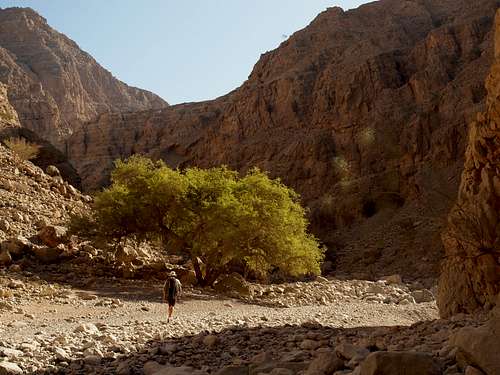-
 10246 Hits
10246 Hits
-
 82.47% Score
82.47% Score
-
 15 Votes
15 Votes
|
|
Mountain/Rock |
|---|---|
|
|
25.76763°N / 56.06942°E |
|
|
1476 ft / 450 m |
|
|
Overview
Red Wall is in the Hajar Mountains which extend in an arc of bare limestone for some 700km through the United Arab Emirates and Oman. The best known cliff is Jebel Misht in Oman, but there are huge amounts of unclimbed rock throughout the range. Much of this is on large rambling cliffs and rock quality is very variable. However established climbs tend to be on the best rock and can be very good. Red Wall is in Wadi Naqab, near Ras Al Khaimah in the UAE. It appears to have been formed by a massive rockfall leaving behind an almost completely vertical face with a large boulder field below. I first saw Red Wall, as I named it, in early 2009 hiking in the area. It struck me as the best wall I had seen in the UAE and I wanted to climb it. I later discovered that John Gregory and Dee McEnery were the first people to attempt a route on Red Wall some time in the late Nineties but were unable to complete the route because they lacked the gear needed to protect the wide cracks. John is a legend in UAE climbing having climbed hundreds of new routes over the years.
Getting There
From Dubai drive to Ras Al Khaimah (one hour) and approach as for Wadi Bih (see map or guidebook). 4WD needed. Then:
- Turn right at the Lantern Roundabout towards the airport.
- Turn left (i.e. U-turn and turn right) at Time Motors after 5 km.
- Turn right at the Archirodon Construction sign after 4.1 km.
- Turn left at the Archirodon sign after 2.5 km.
- Turn right on the dirt track by the tree just before the quarry entrance after 5.3 km.
- Turn right on a gravel track up the wadi bed (300m before a beige steel structure) after 2.7 km.
- Park at the end of the track.
Approach
- The approach originally took us two hours but this has been reduced to one hour since the jeep track has been extended up the valley and we also discovered the goat path described below.
- Walk until you are facing two large wadis. Take the one on the left.
- After about 15 minutes scramble up rocks on the left for a few metres to the start of a goat path which continues up the valley above the wadi bed on a terrace and above a huge boulder field which blocks the valley.
- This path is hard to find but it is close to a large exposed tree root at a big bend in the wadi.
- Eventually the path drops down slightly above the boulder field to rejoin the wadi bed.
- Red wall is above to the right. Walk across the wadi and up to the cliff keeping left.
- Otherwise, if you miss the start of the path, continue until you reach the boulder field.
- Climb a scree gully on the left to join the goat path at a cairn.
Other Info
When to Climb The best time is November to March when blue skies and pleasant temperatures can be expected. Climbing is possible but not pleasant in the summer when temperatures rise above 40 degrees C. Camping Camping is possible just about anywhere in uninhabited areas. In the mountains wadi beds are dangerous if there is a risk of rain. One approach to climbing Vertical Vice would be to bivouac beneath the crag in order to get an early start.
The Route (by Andy LaBonte)
We attempted to climb the route twice in a ground up style but a combination of loose rock and steep terrain on the 5th pitch forced a change of tactics. After this set back, we spent several days over the next few weekends climbing to the top by a different route, and abseiling down to cliff face to clean the certain sections and equip the route with abseil chains in some places. Even though the route was cleaned on abseil prior to the ascent, the remote nature of the cliff made it impossible to clean it completely. Our cleaning efforts were concentrated on removing the odd ‘death block’ stuck to the wall with mud and clearing the cracks of flaky rock inside that might cause gear placements to fail. You can trust the gear placements but like every where else in the UAE, test the face holds before you pull on them. The more you use the crack, the more secure you will feel. Allow one hour for the approach and one hour to walk out. The route took us eight hours to climb and one hour for the abseil descent. So bring headlamps and plenty of water. Gear -2x 60 m Ropes -1 complete set of nuts -1 full set of cams from 12mm (green alien) to 0.75 inch (green camalot) plus: -Doubles of size 1 and 2 (red and gold BD) -Four 3 inch cams (blue BD) -Three 4 inch cams - Lots of slings On cams: You will need a lot of big cams. The crack goes for a long way without changing size in the last two pitches. Taking a single set of cams and hoping to slide the same piece up for a distance or beefing up the rack with lots of hexes is not advised. Don’t bring a knife to a gunfight.




